The full form of OLTAS is On-Line Tax Accounting System which is an online system operated by the Income Tax Department of India. This system aims at the collection, accounting and reporting of direct taxes from individuals as well as companies. The data from these payments is sent directly from the banks to the Tax Information Network (TIN), which is managed by the National Securities Depository Ltd. (NSDL). TIN handles all the information about tax payment challans between the tax department and banks. Now, OLTAS is directly linked to the income tax e-filing portal for easier access and management.
What is On-Line Tax Accounting System (OLTAS)?
The Income Tax Department developed a strategic method for gathering essential information and maintaining records of taxes paid by banks by uploading challan details online. Launched in June 2004, this user-friendly system generates single copy challan-cum-acknowledgement instead of a four copy challan. Every OLTAS challan has a unique identification number popularly known as Challan Identification Number (CIN). CIN helps in identifying every payment uniquely which enables the transfer of details of tax payment by banks to the Income Tax Department.
It further has 3 components:
- BSR Code: Branch code of your bank
- Challan tender date: Cash or cheque deposit date
- Challan series number
You can also check your OLTAS challan status by visiting Protean Tinpan. Click on ‘service’ and choose ‘Challan Status Inquiry’ from the drop-down menu.
Tax Information Network (TIN) is a website launched by National Securities Depository Limited (NSDL) which is responsible for helping the taxpayers with OLTAS challan status enquiry.
Key Features of OLTAS
- Introduction of a single copy challan with tear off taxpayer’s counterfoil. As per OLTAS, taxpayer has to use a single and common challan for the following:
- Challan No. ITNS 280 for regular income tax and corporate taxes
- Challan No. ITNS 281 for the deposit of TCS (Tax Collected At Source) and TDS (Tax Deducted at Source)
- Challan No. ITNS 282 for the payment of direct taxes like wealth tax, gift tax, estate duty, hotel receipts tax, securities transactions tax and expenditure tax
- Challan No. ITNS 283 for payment of Banking Cash Transaction Tax and Fringe Benefits Tax.
- Challan No. ITNS 285 for payment of equalization levy
- Challan No. ITNS 286 for payment under Income Declaration Scheme, 2016.
- Challan No. ITNS 287 for payment under Pradhan Mantri Garib Kalyan Yojana, 2016 (PMGKY)
- You can pay taxes either by visiting any authorized bank branches under OLTAS or online through net banking or debit card.
- Acknowledgment and unique serial number known as Challan Identification Number (CIN)
When paying at a bank branch, the taxpayer receives a tear-off portion of the challan after the bank stamps both the challan and its counterfoil with a unique Challan Identification Number (CIN). This CIN includes the following details:
- 7 digits BSR Code allotted by RBI to the bank branch where tax is deposited
- Date of presentation of the challan (DD/MM/YY)
- 5 digits serial number of Challan in that bank branch on that day
For cash payments, the taxpayer receives the tear-off portion of the counterfoil immediately. For payments by demand draft or cheque, it is given after the payment clears. In the case of online payments, the challan is generated right away after the transaction is processed.
The bank collects all the challan details and sends them electronically to the Income Tax Department. Additionally, paper copies of the challans, along with printed records, are sent to Zonal Accounts Officers. The department uses the information from the banks, based on the Challan Identification Number (CIN), to credit the tax paid.
The CIN is a proof that tax has been paid and has to be quoted in the Income Tax Return/ in further enquiry from the income tax department if any. The Challans are available online on income tax website or at local Income Tax Offices.
- Details of tax paid is available to taxpayers online
Tax payers are now able to view the tax paid by them by logging on to Tax Information Network.
Types of Status Inquiry
- For Taxpayers: Challan status can be checked by using CIN or Tax Deduction and Collection Account (TAN) of the deductor. Status inquiry can be made using two kinds of search:
- CIN based view: By entering the Challan Identification Number (CIN), which includes the BSR Code of the collecting branch, the challan date, and the challan serial number (with the option to enter the payment amount), the taxpayer can view the following details:
- BSR Code (Bank Branch Code)
- Date of Payment
- Challan Serial Number
- Major Head Code and description
- TAN/PAN (Taxpayer’s Identification)
- Name of the Taxpayer
- Date the challan was received by TIN
- Confirmation if the entered amount is correct (if provided)
- TAN based view: By entering the TAN and the Challan Tender Date range for a specific financial year, the taxpayer can view the following details:
- Challan Identification Number (CIN)
- Major Head Code with description
- Minor Head Code
- Nature of Payment
- CIN based view: By entering the Challan Identification Number (CIN), which includes the BSR Code of the collecting branch, the challan date, and the challan serial number (with the option to enter the payment amount), the taxpayer can view the following details:
If the taxpayer enters the payment amount for a specific CIN, the system will verify if it matches the amount uploaded by the bank.
Note: If the message “no records found for the above query” appears while making an inquiry on the website, or if there are any discrepancies in the data, the taxpayer should contact the bank where the tax was deposited. If the issue is not resolved, the taxpayer can email or write to the National Securities Depository Ltd. (NSDL) for further assistance.
- For Banks: Tax collecting branches and nodal branches can track the status of their deposited challans online using the following features:
- Collecting Bank Branch: By entering the branch scroll date and major head code, the collecting branch can view the total amount and number of challans for each major head code. The branch can also see:
- Challan Serial Number
- Challan Tender Date
- PAN/TAN
- Taxpayer’s Name
- Amount
- Date received by TIN
- Nodal Bank Branch: By providing the nodal scroll date and major head code, the nodal branch can access:
- Nodal Branch Scroll Number
- Scroll Date
- Major Head Code and Description
- Total Amount
- Number of Branches
- Number of Challans
- For each Nodal Branch Scroll Number, the following details are also available:
- BSR Code
- Branch Scroll Number
- Branch Scroll Date
- Total Amount
- Number of Challans
- Date received by TIN
- Collecting Bank Branch: By entering the branch scroll date and major head code, the collecting branch can view the total amount and number of challans for each major head code. The branch can also see:
OLTAS Tax Refund
The income tax department returns you the excess amount, if your income tax paid is more than the income tax liability for one year. This refund amount is known as ‘Income Tax Refund’ which can be processed by the TIN portal.
Step 1: Login to the TIN website by clicking on Protean Tinpan
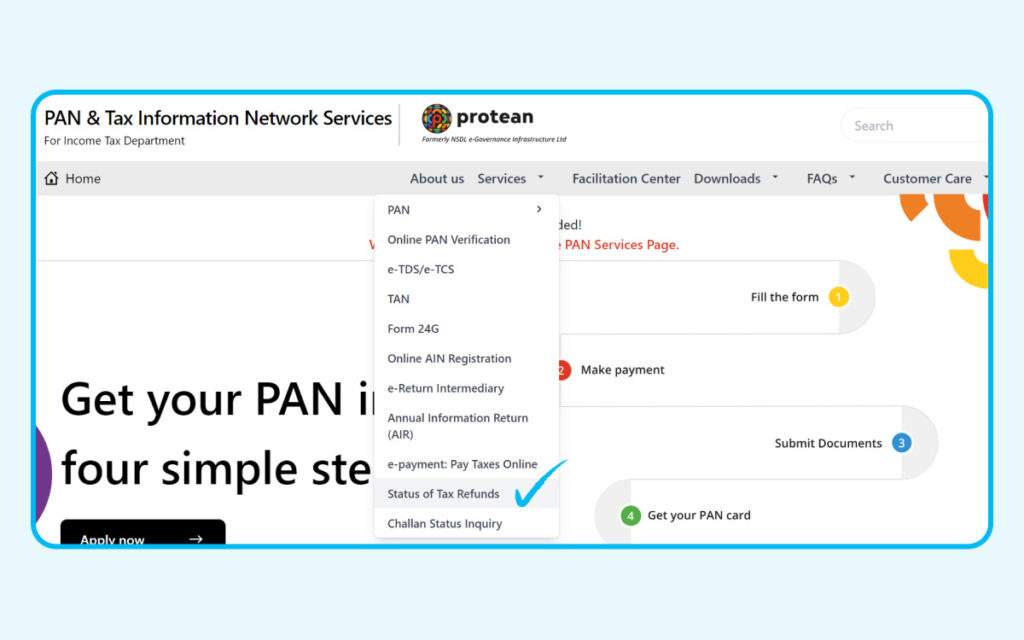
Step 2: Select the ‘service’ option and then click on ‘Status of Tax Refunds’ under the drop down menu.
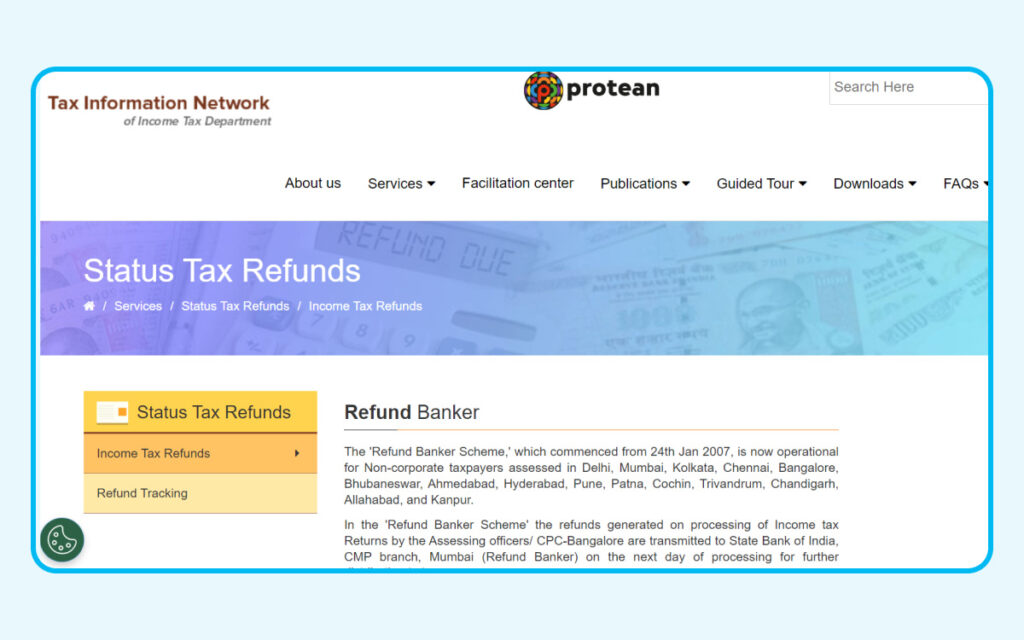
Srep 3: Click on the ‘Refund Tracking’ option displayed on the left side of the page under ‘Status Tax Refunds’.
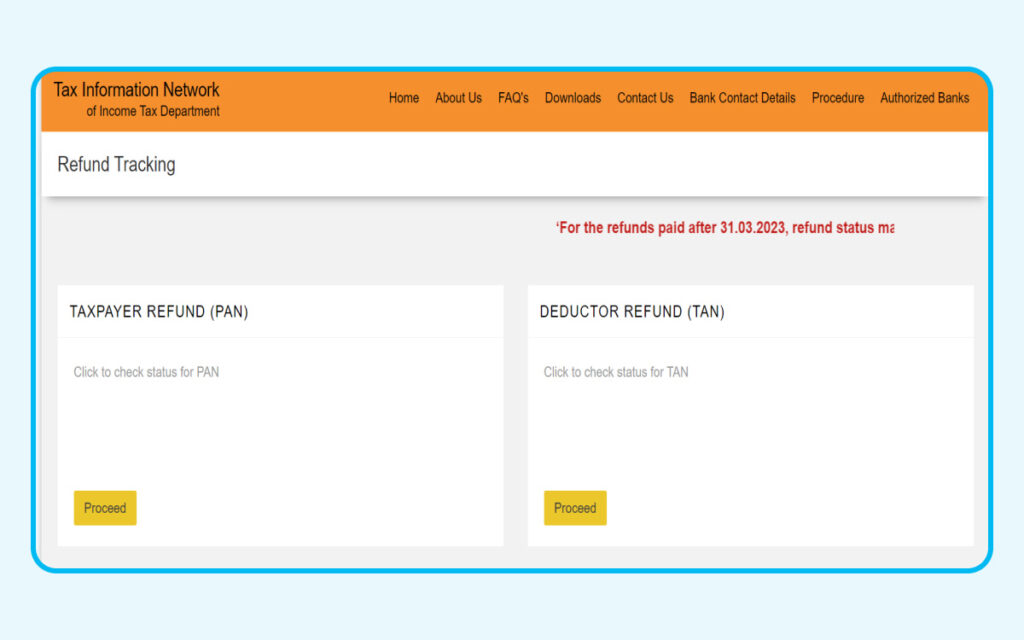
Step 4: Choose the ‘Taxpayer Refund (PAN)’ option by clicking on proceed. Enter the login credentials of your account and click on ‘submit’
Step 5: Your tax refund status will be displayed.
Challan Enquiry Through OLTAS
For any OLTAS challan status enquiry, follow the below mentioned steps:
Step 1: Visit the TIN website
Step 2: Choose the valid option from ‘CIN based view’ or ‘TAN based view’. Refer to the details mentioned on the website below if you face any difficulty in this step.
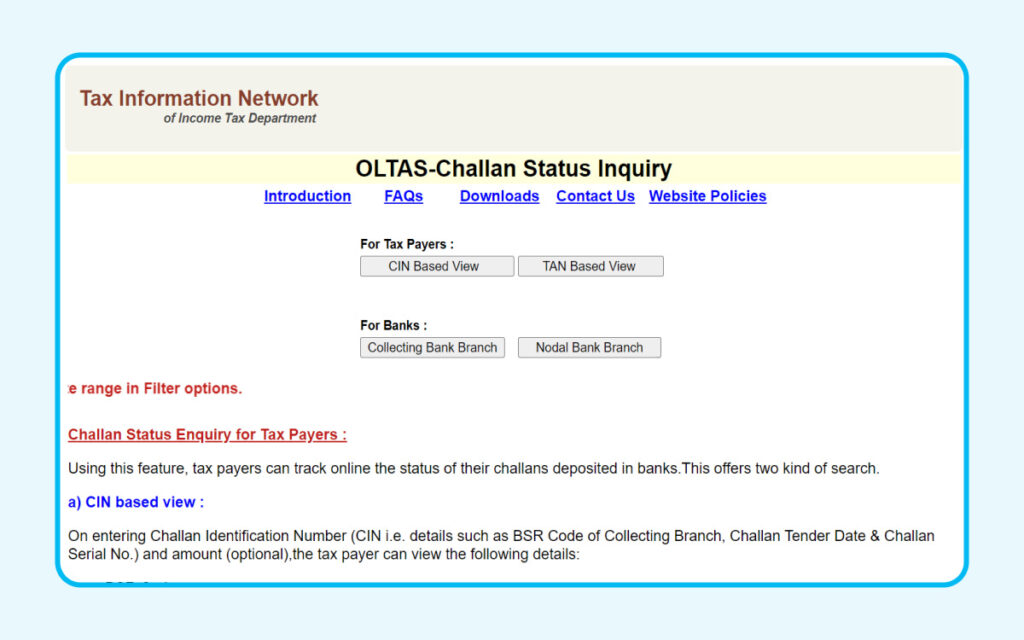
Step 3: For ‘CIN based view’ fill in information like BSR code, Challan Tender date, Challan serial number and amount. You can find all the details stamped on the acknowledgement for challan given by the bank.

Step 4: For ‘TAN based view’ fill in information like TAN number and challan tender date.
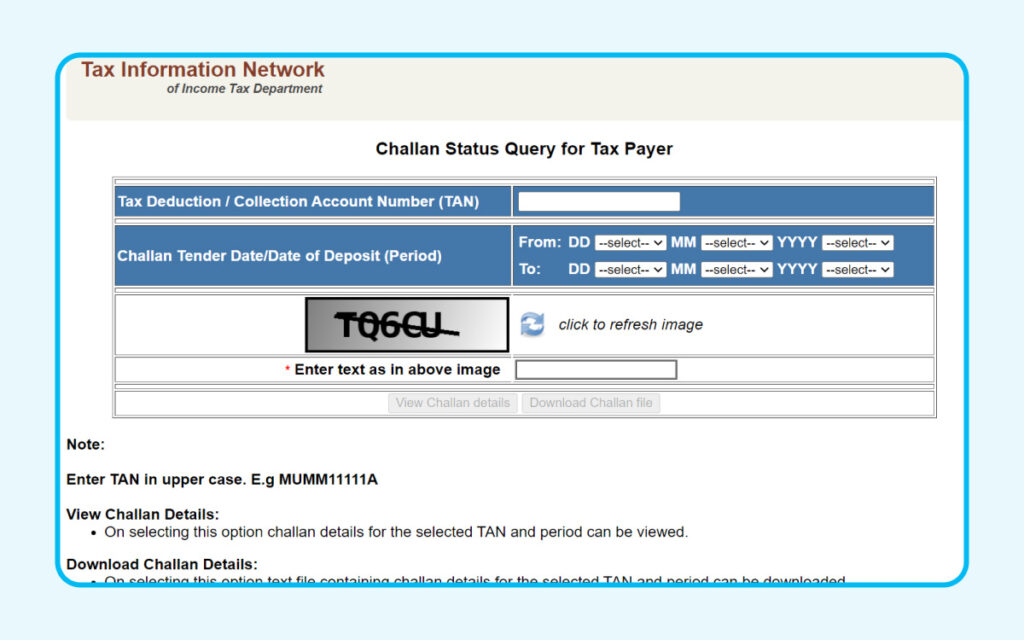
A message will be displayed on your screen confirming if the challan has been received by the TIN or not. You can verify all the details regarding your challan now.
Advantages of OLTAS
- Real-time updates: OLTAS login and registration helps the taxpayers with real time updates on inquiries like tax payments, transactions, OLTAS challan status enquiry and many more.
- Convenience: OLTAS website has made the process of tax paying and status checking easier for the user
- High-end security: To protect the confidential data of the taxpayers, OLTAS uses powerful authentication and encryption methods.
- Efficiency: The taxpayers can pay their tax through OLTAS login which ensures efficient payment of tax collection on time.


